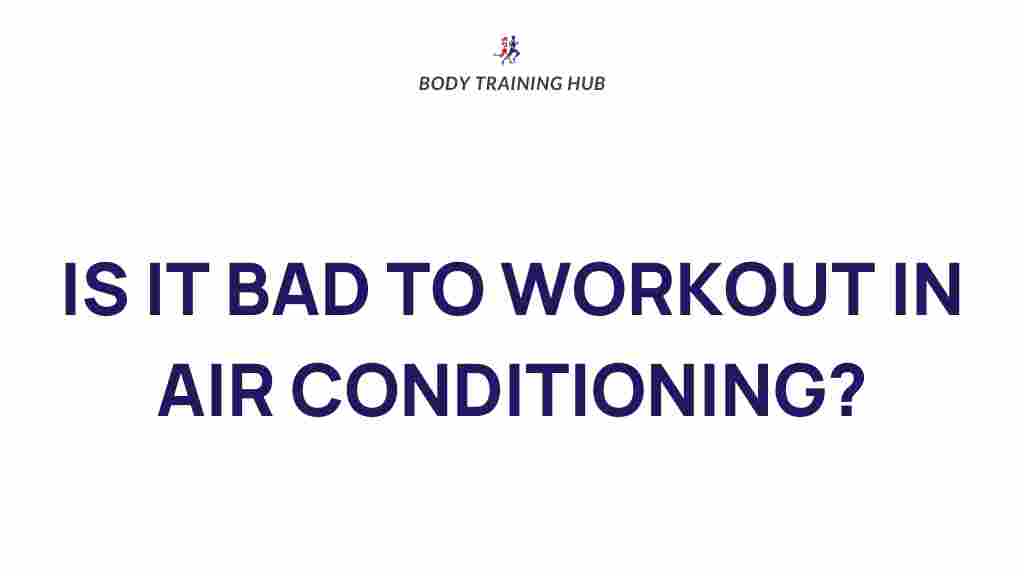Workout in Air Conditioning: The Surprising Impact on Performance
When it comes to fitness, most of us prioritize our workout routines, nutrition, and overall health. However, one factor that often gets overlooked is the environment in which we exercise. Specifically, the impact of air conditioning on our workout performance. In this article, we will unveil the surprising effects of exercising in air conditioning, discussing its benefits, drawbacks, and how it influences our fitness journey.
The Importance of Temperature in Fitness
The temperature of your workout environment can significantly affect your performance and overall fitness levels. Here’s how:
- Comfort Levels: Exercising in a controlled temperature can enhance comfort, allowing you to focus more on your workout rather than the heat.
- Hydration: Cooler environments can reduce sweat loss, making it easier to maintain hydration levels.
- Energy Levels: A comfortable temperature can help sustain your energy levels, enabling you to push through your workouts.
Benefits of Exercising in an Air-Conditioned Environment
Air conditioning can have several benefits when it comes to your workout routine:
- Improved Performance: Studies show that exercising in cooler temperatures can lead to improved performance. When your body is not overheated, you can train harder and longer.
- Reduced Risk of Heat-Related Illness: Exercising in high temperatures can lead to heat exhaustion or heat stroke. Air conditioning helps mitigate these risks.
- Enhanced Recovery: Cooler environments can aid in recovery post-exercise, reducing inflammation and soreness.
- Increased Motivation: A comfortable environment can make you more likely to stick to your workout routine, as it feels less daunting to exercise.
Drawbacks of Exercising in Air Conditioning
While there are many benefits to working out in air conditioning, there are also some drawbacks to consider:
- Over-Reliance: Relying too much on air conditioning can make it difficult to exercise in natural environments or in warmer conditions.
- Potential for Colds: Constant exposure to cold air can increase the risk of catching colds or respiratory issues.
- Equipment Limitations: Not all gyms or fitness centers have adequate air conditioning, which can limit your options.
How to Optimize Your Workout in Air Conditioning
To maximize the benefits of exercising in an air-conditioned environment, consider the following steps:
1. Choose the Right Temperature
The ideal temperature for a workout is typically between 68°F and 72°F (20°C to 22°C). This range helps maintain comfort while allowing for optimal performance. Adjust your air conditioning settings accordingly.
2. Stay Hydrated
Even though you might sweat less in an air-conditioned environment, hydration remains crucial. Drink plenty of water before, during, and after your workout to keep your body functioning optimally.
3. Incorporate Warm-Up and Cool-Down Routines
Warming up before your workout and cooling down afterward can help your body adjust to the temperature changes, reducing the risk of injury and improving recovery times.
4. Dress Appropriately
Wear breathable, moisture-wicking fabrics that help keep your body cool without causing overheating. Avoid heavy clothing that can trap heat.
5. Listen to Your Body
Pay attention to how your body responds to the air conditioning. If you feel cold or uncomfortable, adjust the temperature or your workout intensity accordingly.
Troubleshooting Common Issues
Here are some common issues you may encounter while working out in air conditioning, along with troubleshooting tips:
Feeling Too Cold
- Adjust the Thermostat: If you find the temperature too low, increase it gradually until you find a comfortable level.
- Layer Up: Consider wearing a light jacket or long sleeves during your workout if you are sensitive to cold.
Dry Air Irritation
- Use a Humidifier: If the air feels too dry, a humidifier can help maintain moisture levels.
- Stay Hydrated: Drink more water to combat the drying effects of air conditioning.
Difficulty Adjusting
- Gradual Acclimatization: If you’re not used to exercising in cooler conditions, take a few sessions to acclimatize before pushing yourself too hard.
- Mix It Up: Combine workouts in air conditioning with outdoor training to build adaptability.
Conclusion: Find Your Balance
Exercising in air conditioning can significantly impact your performance, fitness, and overall enjoyment of your workout. While it offers numerous benefits, such as improved performance and reduced risk of heat-related illness, it is essential to be aware of the potential drawbacks as well. By optimizing your workout environment and following the tips outlined in this article, you can create a balanced approach to your fitness routine.
Remember, the key lies in finding what works best for your body and preferences. Whether you prefer the comfort of air conditioning or the invigorating feeling of outdoor workouts, each environment has its unique advantages. For more tips on enhancing your fitness journey, check out our comprehensive fitness guide.
Ultimately, understanding the relationship between your workout environment and performance can lead to a more effective and enjoyable fitness experience. Embrace the benefits of air conditioning while staying mindful of your body’s responses, and you’ll find yourself reaching new heights in your fitness goals.
For research on temperature effects on athletic performance, visit this external resource.
This article is in the category Strength & Recovery and created by BodyTraining Team
